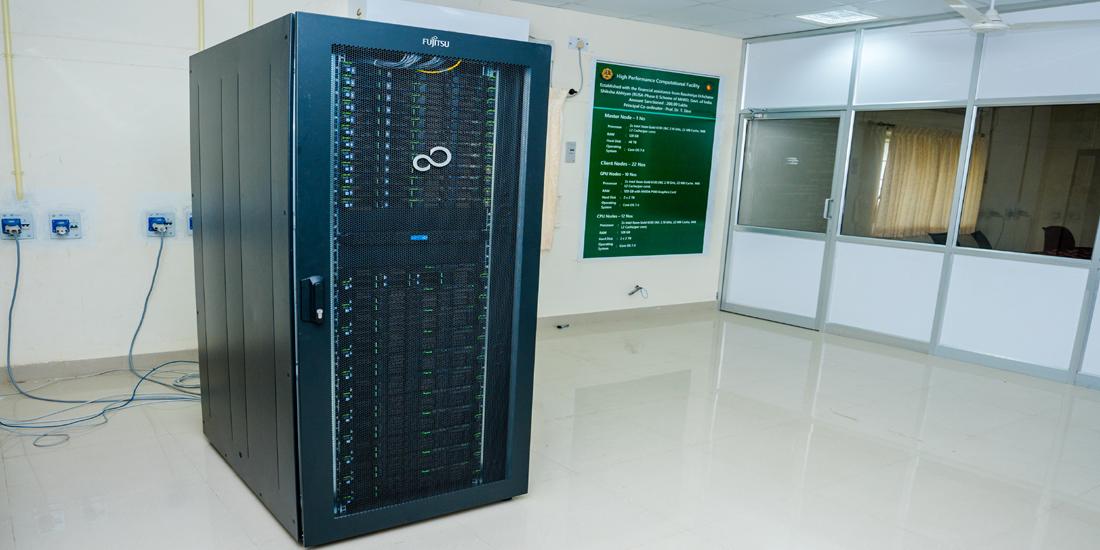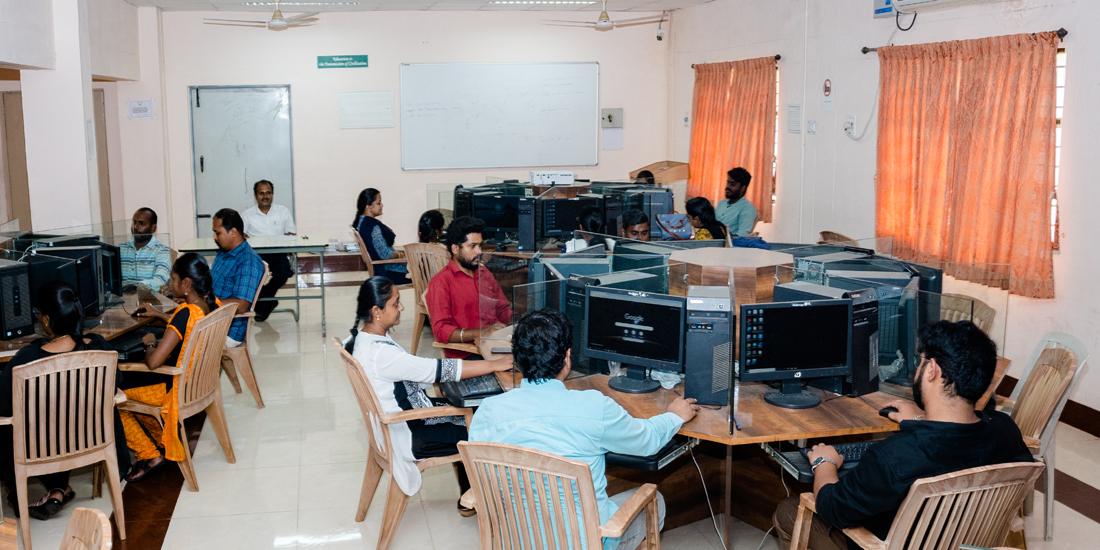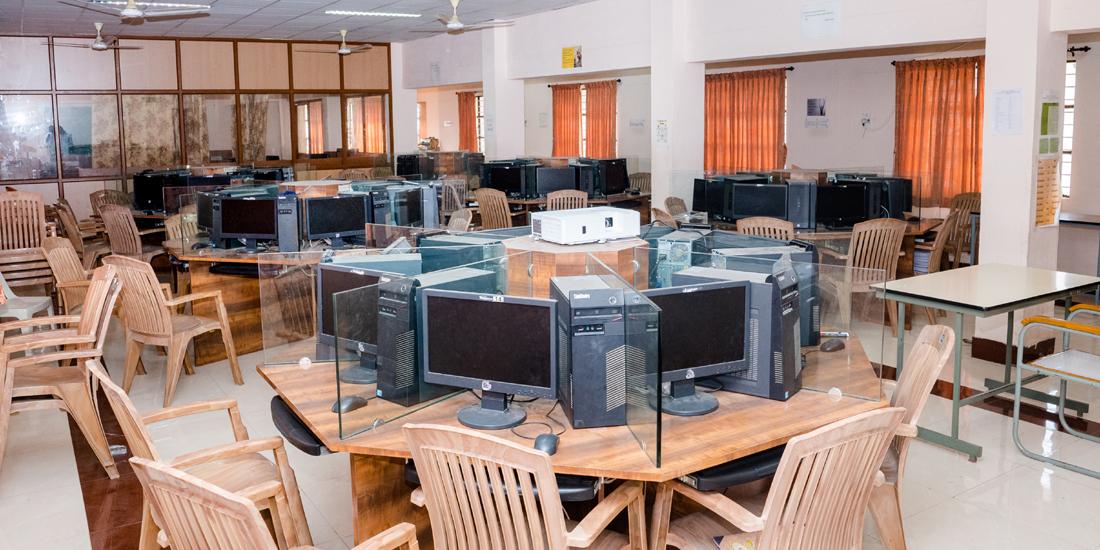- Department Projects
-
1. UGC-BSR
The UGC_BSR scheme has created an infrastructure facility for the department and also provided funding support for two Ph.D. scholars.
Amount Utilized: Rs. 10 Lakhs for Lab Infrastuture; Rs. 7.2 Lakhs (2011-12, 12-13) Lakhs for Fellowships
The infrastructure created under this scheme are:
Computer Lab Furniture
Computer Table – 16 Nos., Workstation Octagon shape Table – 6 Nos.
Drinking Water Facility to Students
Water Purifier – 2 Nos., Water Doctor Hima7NHC – 1 Nos.
Networking Infrastructure
24 Port Switch
Networking & ElectricalItems
Printers
HP Laser Jet M1005 Printer – 1 No.
Power Backup Infrastructure
2 Nos of UPS and 20 Nos of Exide Batteries – 2 Sets
Computers
Server(Quad-Core Intel xeon Processor) – 1 Nos. Net Book Computers – 2 Nos.
Other Accessories
External DVD writer
D-11 Optical USB MouseUnder UGC_BSR scheme, two PhD research scholars have been awarded fellowship, Ms.Bhuvaneswari. P and Mr. N.Pratheesh. A brief abstract of their research work and significant research outcome in terms of publications are given below.
Ms. P. Bhuvaneswari, Fellow - BSR
Title of Research : Development of an efficient Epilepsy Detection System using Electroencephalography
Abstract:
Brain is the intelligent part which contains millions of neurons interconnected with each other. Epilepsy is the critical brain disorder suffered by approximately 1% of the total population and it can be identified through brain signals. Brain signals are measured with the help of efficient modality called Electroencephalography (EEG). The entire clinical oriented neurologist can use the EEG which shows the immediate changes in brain activity related to epilepsy disorders.
Primary contribution of this research work includes, study on epilepsy detection and related brain disorders based on the signal processing techniques. Epilepsy detection includes various phases includes, Preprocessing, Artifact Removal, Sub band Extraction, Feature Extraction and Classification.
Various artifact detection and removal methods are studied. Feature extraction methods are applied for real time data for visualize the influence of epilepsy detection. Total variation based feature extraction method has been developed. Different machine learning methods are used for understanding the normal and abnormal behavior of the brain activity. Classification accuracy for epilepsy analysis for combined multi feature analysis has been implemented. An efficient real time epilepsy detection system are designed and developed. Behavior analysis for multiple stimulus like eyes open, eyes close, teeth biting, thinking and emotion detection are implemented with higher classification accuracy.
Publications
[1]. P. Bhuvaneswari, J. Satheesh Kumar, A role of Principal Component Analysis in Electroencephalography Signal Analysis, ICCT, 989-991, 2014.
[2]. P. Bhuvaneswari, J. Satheesh Kumar, Feature Extraction Methods using EEG Signal Analysis, IJRCSIT, 12-19, 2014.
[3]. P. Bhuvaneswari, J. Satheesh Kumar, Support Vector Machine Technique for EEG Signals, IJCA, 63(13), 1-5, 2013.
[4]. P. Bhuvaneswari, J. Satheesh Kumar, A Comprehensive Survey on EEG Signal Classification Algorithms, Proc. of ICDMSCT, 2013.
[5]. P. Bhuvaneswari, J. Satheesh Kumar, Analysis of Electroencephalography (EEG) Signals and its Categorization –A Study, Procedia Engineering, ELSEVIER, 38, 2525– 2536, 2012.
[6]. P. Bhuvaneswari, J. Satheesh Kumar, Methods used for identifying EEG Signal Artifacts, ELSEVIER, 355-359, 2012.
[7]. P. Bhuvaneswari, J. Satheesh Kumar, A Note on Electroencephalography (EEG) and its Applications on Human Brain, Proc. Of MMASC, 942-953, 2012.
[8]. P. Bhuvaneswari, J. Satheesh Kumar, A note on Brain Image Analysis, Proc. Of NCRTACT, 200-202, 2012.Pratheesh . N, Fellow - BSR
Research Abstract:
The scholar’s research is concerned with the study, analysis and importance of software engineering; issues in teaching approaches and to improve the performance and effectiveness of teaching software engineering course using learning analytics. Web based tool support environment for software engineering teaching has been designed. The prototype has been tested using software engineering students. Class students were divided into two groups using systematic random sampling method. The collected data were analysed using statistical methods such as descriptive statistics, mann-whitney U test, wilcoxon signed rank test and kolmogorov-smirnov test to measure the performance of the system. The test results proved that the tool support environment increases the teaching and learning effectiveness and hence successful.Publications
1.Pratheesh, N., Devi, T., and PrithviVidhya, P., 2012. Web Enabled Learning Tool for Software Requirements Analysis. International Journal of Software Engineering Research & Practices, 2(1), 6-11.
2.Pratheesh, N., and Devi, T., 2013. Design and Developmet of an Algorithm for Dynamic Assessment of the Learning Style of Software Engineering Students. Journal of Engineering, Computers & Applied Sciences, 2(12), 43-48.
3.Pratheesh, N., and Devi, T., 2013. Influence of Learning Analytics in Software Engineering Education. Proceeding of the IEEE International Conference on Emerging Trends in Computing, Communication and Nanotechnology (ICECCN 2013), IEEEXplore, 712-716.
4.Pratheesh, N., and Devi, T., 2013. Assessment of Student’s Learning Style and Engagement in Traditional Based Software Engineering Education. Proceeding of the IEEE International Conference on Intelligent Interactive Systems and Assistive Technologies (IISAT’ 13), IEEEXplore, 25-31.
5.Pratheesh, N., and Devi, T., 2013. Sensation of Learning Analytics to Prevail the Software Engineering Education. Proceedings of the International Conference on Advanced Computing and Communication Systems (ICACCS -2013), IEEExplore.
6.Pratheesh, N., and Devi, T., Necessity of Learning Analytics in Software Engineering Education, Journal of Engineering Science and Technology–Accepted for Volume 10, Issue 5 (October, 2015). SCOPUS Indexed Journal
2. High Performance Computational Facility (HPCF)
The High Performance Computational Facility has been equipped with advanced technologies to perform the high-end computations for the academic community. This facility will be able to address and catalyze the research and promises to be a boon to the academic community. Additionally, it will help in creating a workforce that is aware of High Performance Computing skills (capacity building) and promote research and teaching by integrating leading-edge emerging technologies.
Utilization of funds
The sanctioned fund amount of 200.00 lakhs has been utilized for acquiring and the installation of the required hardware, software applications and for miscellaneous needs.
Facilities Created
Hardware:
1. Master Node – 1 No
Form Factor 2U Rack mountable
Processor 2 x Intel Xeon E5-2683 v4. 16 Core and 40MB Cache
Memory Should be configured with 128 GB RAM Memory should be scalable to double the capacity configured
Storage NLSAS for a storage of 32TB (i.e 4 x 8 TB)
RAID Controller RAID Controller with min 2 GB Cache and should support RAID 0,1,5,6,10
2 Compute Nodes –10 NosGPU
Form Factor 1U Rack mountable
Processor 2 x Intel Xeon E5-2683 v4. 16 Core and 40MB Cache
Memory Should be configured with 128 GB RAM Memory should be scalable to double the capacity configured
Internal HDD 2 x 2 TB SATA HDD drives
GPU 1 x NVIDIA P100 12GB Modules3 Compute Nodes –12 NosCPU
Form Factor 1U Rack mountable
Processor 2 x Intel Xeon E5-2683 v4. 16 Core and 40MB Cache
Memory Should be configured with 128 GB RAM Memory should be scalable to double the capacity configured
Internal HDD 2 x 2 TB SATA HDD drivesSoftware:
Operating System: Latest Optimized Open source Linux OS with support for High Performance Computing
Cluster Management Software: Open source ROCKS optimized for HPC
Compilers: Open source ForTran 77/90/95, Parallel ForTran for main system, ANSI C, C++ with corresponding Parallel language for the parallel computing, Perl, Python, Parallel compilers for MPI & Open MP, symbolic debugging tools with source line display and source language program for matter where appropriate.
Libraries: Open Source Standard mathematical, statistical, and numerical function libraries, Standard scientific functions libraries, Parallel Libraries for MPI & Open MP, MKL, Latest X11 with MOTIF; Open source libraries LAPACK, BLAS, FFTW etc
HPCApplicationsApplication
GROMACS, R, Gaussian09, Molpro, VASP, Quantum Espresso, MySQL, SCILAB, PythonPresent Status
The HPC facility has been successfully implemented in the computer applications department of Bharathiar University, Coimbatore-46.
Outcome
Research works that require the processing of voluminous data are carried out by researchers within the university and from outside colleges.
- Collaborations
-
- Collaborated with ICTACT for offering training on State-of-art technologies and digital tools to faculty members
- Collaborated with Tata Consultancy Services for offering PGDCA Cognitive Systems since 2019
- Collaborated with CSCC Labs, Hyderabad for offering M.Sc. Cyber Security since 2020
- MoUs
-





 Campus Walk
Campus Walk